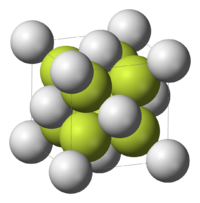Thorium dioxide
 |
|
| Names | |
|---|---|
|
IUPAC names
Thorium dioxide
Thorium(IV) oxide |
|
| Other names
thoria
thorium anhydride |
|
| Identifiers | |
|
3D model (Jmol)
|
|
| ECHA InfoCard | 100.013.842 |
|
PubChem CID
|
|
|
|
|
|
| Properties | |
| ThO2 | |
| Molar mass | 264.04 g/mol |
| Appearance | white solid |
| Odor | odorless |
| Density | 10.00 g/cm3 |
| Melting point | 3,390 °C (6,130 °F; 3,660 K) |
| Boiling point | 4,400 °C (7,950 °F; 4,670 K) |
| insoluble | |
| Solubility | insoluble in alkali slightly soluble in acid |
| −16.0·10−6 cm3/mol | |
|
Refractive index (nD)
|
2.200 (thorianite) |
| Structure | |
| Fluorite (cubic), cF12 | |
| Fm3m, No. 225 | |
|
a = 559.74(6) pm
|
|
| Tetrahedral (O2−); cubic (ThIV) | |
| Thermochemistry | |
|
Std molar
entropy (S |
65.2(2) J K−1 mol−1 |
|
Std enthalpy of
formation (ΔfH |
−1226(4) kJ/mol |
| Hazards | |
| Flash point | Non-flammable |
| Lethal dose or concentration (LD, LC): | |
|
LD50 (median dose)
|
400 mg/kg |
| Related compounds | |
|
Other cations
|
Hafnium(IV) oxide Cerium(IV) oxide |
|
Related compounds
|
Protactinium(IV) oxide Uranium(IV) oxide |
|
Except where otherwise noted, data are given for materials in their standard state (at 25 °C [77 °F], 100 kPa).
|
|
|
|
|
| Infobox references | |
Thorium dioxide (ThO2), also called thorium(IV) oxide, is a crystalline solid, often white or yellow in color. Also known as thoria, it is produced mainly as a by-product of lanthanide and uranium production.Thorianite is the name of the mineralogical form of thorium dioxide. It is moderately rare and crystallizes in an isometric system. The melting point of thorium oxide is 3300 °C – the highest of all known oxides. Only a few elements (including tungsten and carbon) and a few compounds (including tantalum carbide) have higher melting points. All thorium compounds are radioactive.
Thoria exists as two polymorphs. Thoria has the fluorite crystal structure. This is uncommon among binary dioxides (other examples include cerium dioxide, hafnium dioxide, uranium dioxide and plutonium dioxide). The band gap of thoria is about 6 eV. The tetragonal form of thoria is also known.
At extremely high temperatures, it evolves oxygen, giving the black monooxide ThO.
Thorium dioxide (thoria) can be used in nuclear reactors as ceramic fuel pellets, typically contained in nuclear fuel rods clad with zirconium alloys. Thorium is not fissile (but is "fertile", breeding fissile uranium-233 under neutron bombardment); hence, it must be used as a nuclear reactor fuel in conjunction with fissile isotopes of either uranium or plutonium. This can be achieved by blending thorium with uranium or plutonium, or using it in its pure form in conjunction with separate fuel rods containing uranium or plutonium. Thorium dioxide offers advantages over conventional uranium dioxide fuel pellets, because of its higher thermal conductivity (lower operating temperature), considerably higher melting point, and chemical stability (does not oxidize in the presence of water/oxygen, unlike uranium dioxide).
Thorium dioxide can be turned into a nuclear fuel by breeding it into uranium-233 (see below and refer to the article on thorium for more information on this). The high thermal stability of thorium dioxide allows applications in flame spraying and high-temperature ceramics.
...
Wikipedia
